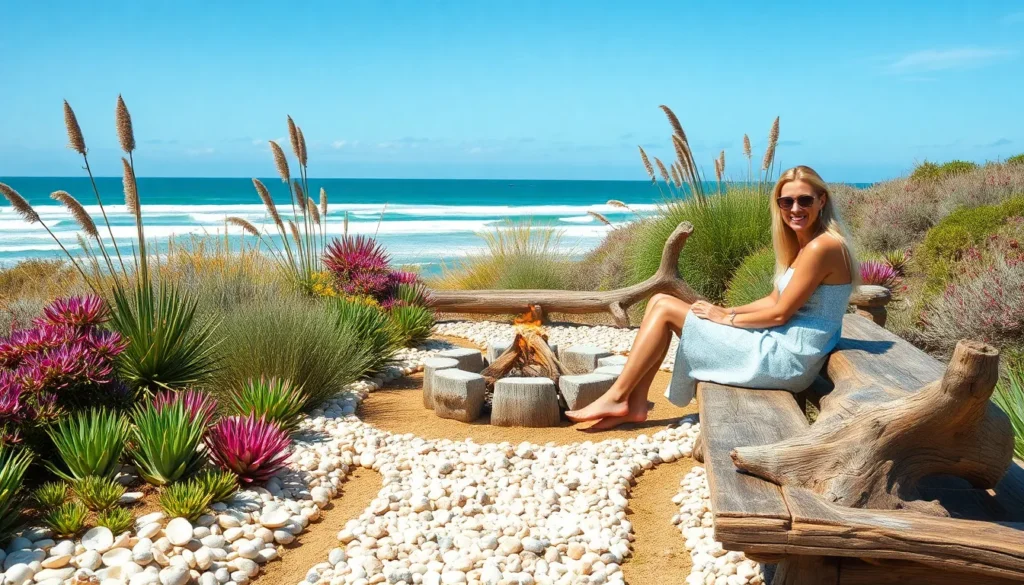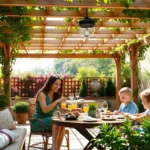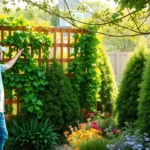Living by the coast doesn’t mean you can’t create a stunning garden that thrives in sandy soil and salty air. We’ve discovered that coastal gardening presents unique opportunities to design breathtaking outdoor spaces that complement your beachside lifestyle perfectly.
The secret lies in embracing plants that actually love the challenges of coastal environments. From salt-tolerant succulents to wind-resistant ornamental grasses, we’ll show you how to transform your sandy plot into a lush paradise that requires minimal maintenance while delivering maximum visual impact.
Whether you’re dealing with constant ocean breezes or looking to create a private retreat that feels like a natural extension of the beach itself, we’ve gathered the most effective strategies and plant selections that’ll make your neighbors envious. These aren’t just garden ideas – they’re proven answers that work beautifully in coastal conditions.
Choose Coastal Plants That Thrive in Sandy Soil
Sandy coastal soil presents unique growing conditions that require specially adapted plants. We’ve identified the most resilient plant varieties that flourish in beach environments while creating stunning visual displays.
Salt-Tolerant Perennials for Year-Round Color
Blanket flowers (Gaillardia) deliver vibrant red and yellow blooms from spring through fall, requiring minimal water once established. These hardy perennials spread naturally to create colorful ground cover that withstands salt spray and sandy conditions.
Sea lavender produces delicate purple flower clusters that dry beautifully for indoor arrangements. This Mediterranean native thrives in poor, sandy soil while attracting beneficial pollinators throughout the growing season.
Beach asters bloom in late summer with purple daisy-like flowers that complement coastal landscapes perfectly. We recommend planting these native perennials in clusters for maximum visual impact along pathways and garden borders.
Seaside goldenrod creates stunning yellow displays in fall when most other plants fade. This native wildflower self-seeds readily in sandy soil, establishing natural colonies that require zero maintenance.
Native Beach Grasses for Natural Movement
Dune grass (Ammophila breviligulata) serves as the backbone of coastal gardens with its tall, graceful movement in ocean breezes. This native species helps prevent soil erosion while creating natural privacy screens that reach 3-4 feet in height.
Little bluestem adds fine texture and copper fall color to beach garden designs. We plant this ornamental grass in masses to create flowing transitions between planted areas and natural dune landscapes.
Switch grass tolerates salt spray exceptionally well while providing habitat for coastal birds. This versatile native grows 4-6 feet tall and turns golden bronze in autumn, maintaining structure through winter months.
Buffalo grass forms dense, low-maintenance ground cover that withstands foot traffic and salt exposure. This drought-tolerant option requires minimal watering once established and stays green longer than traditional lawn alternatives.
Drought-Resistant Succulents for Low Maintenance
Prickly pear cactus produces bright yellow flowers followed by edible purple fruits, thriving in the harshest coastal conditions. These architectural plants create striking focal points while requiring watering only during extended dry periods.
Ice plant spreads rapidly to form colorful ground cover with daisy-like flowers in pink, purple, or yellow. We use this succulent on slopes and areas where other plants struggle to establish.
Sedum varieties offer diverse textures and colors from blue-green ‘Autumn Joy’ to burgundy ‘Dragon’s Blood’. These versatile succulents work well in containers, rock gardens, and as living mulch around larger plants.
Aloe species bring sculptural interest with their rosette forms and occasional flower spikes. These water-wise plants store moisture in their thick leaves, making them perfect for areas that receive inconsistent irrigation.
Create Natural Windbreaks Using Strategic Plant Placement
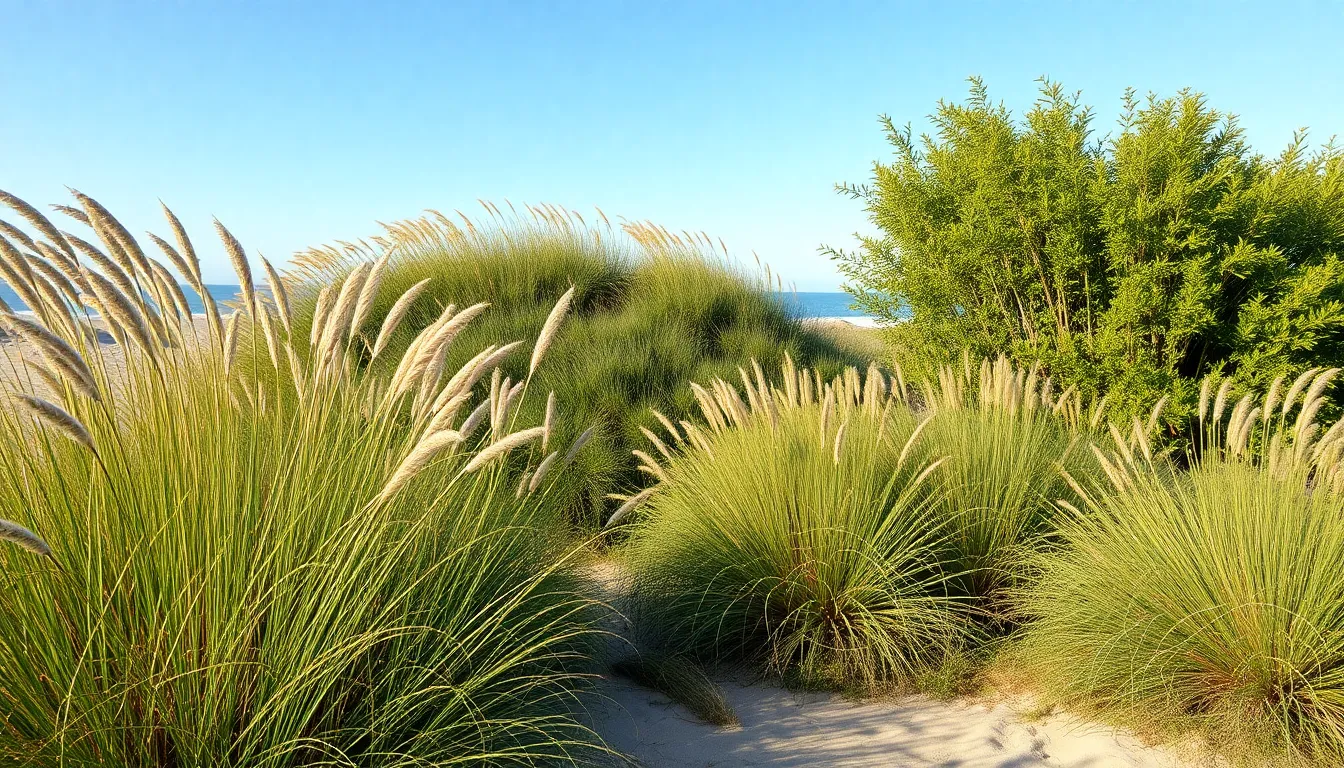
Strategic windbreak placement transforms exposed coastal properties into protected garden sanctuaries. We position wind-tolerant species in dense rows perpendicular to prevailing winds to reduce wind speed and minimize salt exposure.
Tall Ornamental Grasses as Living Screens
Pampas grass creates stunning 8-foot screens that sway gracefully in coastal breezes. We plant Cortaderia selloana in clusters of 3-5 specimens spaced 4-6 feet apart for maximum wind blocking effectiveness.
Sea oats form dense barriers while adding architectural interest to beach gardens. Chasmanthium latifolium grows 3-4 feet tall and provides excellent salt tolerance with minimal maintenance requirements.
Switchgrass establishes quickly and creates thick screening walls in just one growing season. We use Panicum virgatum for its rapid growth habit and ability to withstand strong coastal winds year round.
Native beach grasses combine beautifully to form layered windbreak systems. We mix different heights and textures to create natural barriers that protect delicate plants behind them.
Evergreen Shrubs for Permanent Protection
Shore juniper spreads low and dense to form living walls against salt spray. We plant Juniperus conferta in staggered rows to create impenetrable barriers that require virtually no maintenance.
Wax myrtle grows into robust 6-8 foot screens with glossy evergreen foliage. Myrica cerifera tolerates salt spray exceptionally well while providing year round wind protection for garden spaces.
Yaupon holly develops thick branching patterns perfect for blocking harsh coastal conditions. We use Ilex vomitoria as permanent screening because its dense growth habit stabilizes soil and prevents erosion.
Evergreen combinations work best when we layer different heights and growth habits. We plant taller species like wax myrtle behind lower growing shore juniper for maximum protection.
Bamboo Clusters for Privacy and Sound Barriers
Clumping bamboo varieties grow rapidly into dense privacy screens without invasive spreading. We choose Bambusa species for their upright growth habit and excellent salt tolerance in coastal environments.
Fargesia bamboo thrives in windy conditions while forming tight clusters for sound buffering. We plant these cold hardy varieties 3-4 feet apart to create solid barriers within 2-3 growing seasons.
Strategic cluster placement maximizes privacy while controlling growth patterns effectively. We position bamboo groves to block sight lines from neighbors and muffle traffic noise naturally.
Maintenance requirements remain minimal once bamboo clusters establish their root systems. We simply remove dead canes annually and thin overcrowded areas to maintain healthy growth patterns.
Design Pathways Using Beach-Inspired Materials
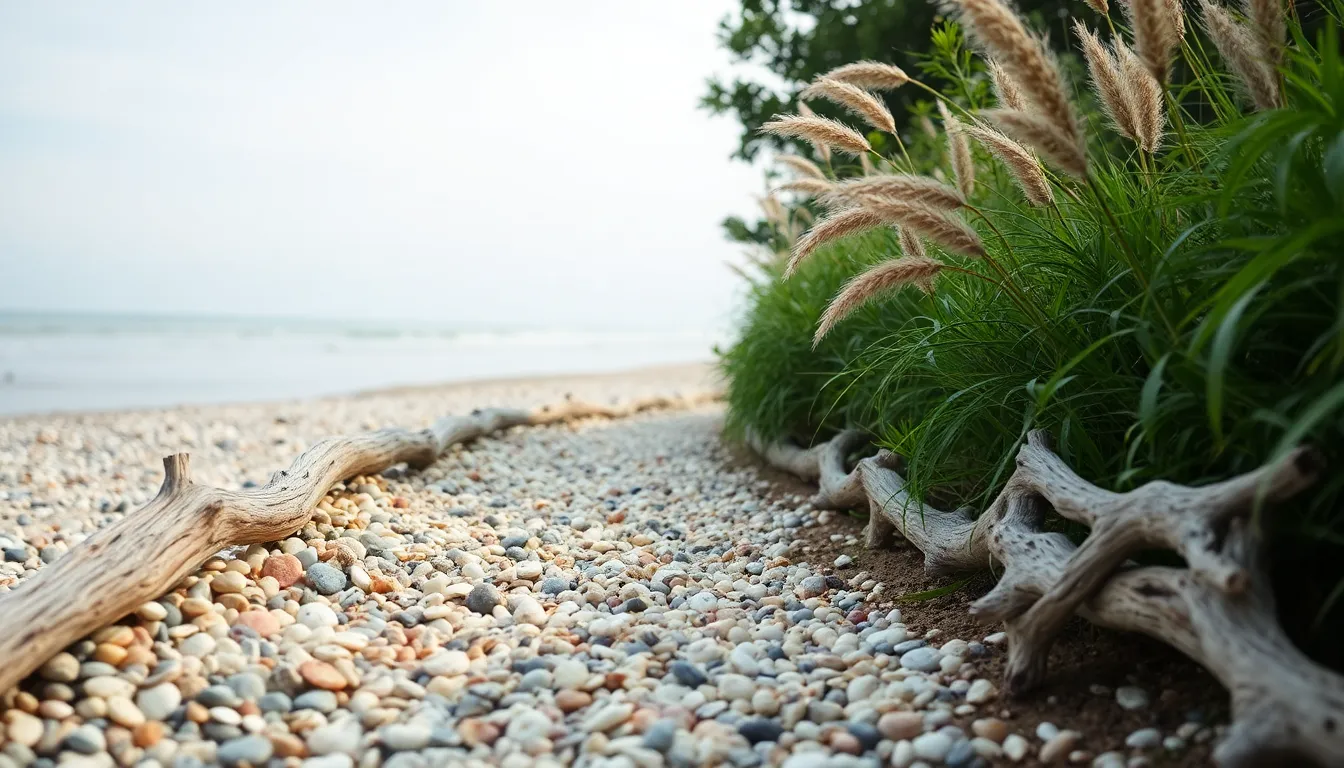
We’ll transform our coastal garden walkways using natural materials that capture the essence of beachside living. Creating pathways with ocean-inspired elements helps establish a seamless connection between our garden and the surrounding coastal environment.
Shell and Pebble Walking Trails
Shell pathways bring authentic coastal charm to our garden while providing excellent drainage for sandy soil conditions. We can collect various shells like clam shells, scallop shells, and oyster shells to create textured walking surfaces that crunch pleasantly underfoot. Mixed pebble trails using smooth river rocks, beach glass, and weathered stones add visual interest through their varied colors and sizes.
Durability makes shell and pebble combinations perfect for withstanding harsh coastal conditions including salt spray and strong winds. We’ll arrange larger shells as border elements while filling pathway centers with smaller crushed shells and pebbles for comfortable walking. Regular maintenance involves simply raking the surface to redistribute materials and adding fresh shells seasonally.
Driftwood Borders for Rustic Appeal
Driftwood borders create stunning natural edging that perfectly complements our beach garden aesthetic. We can position weathered driftwood pieces along pathway edges to define walking areas while adding rustic coastal character. Collecting driftwood from local beaches ensures our borders match the natural weathering patterns of our coastal environment.
Arranging driftwood in varying heights and angles creates ever-changing visual lines that guide visitors through our garden spaces. We’ll select pieces with interesting shapes, holes, and silver-gray weathering to maximize their decorative impact. Larger driftwood logs serve as natural seating areas along pathways, while smaller pieces work well as plant supports and decorative accents.
Sand-Stabilized Stone Pavers
Stone pavers embedded in sand create stable walking surfaces that maintain our beach garden’s sandy aesthetic. We’ll choose natural stone materials like flagstone, slate, or limestone that complement coastal colors and textures. Sand stabilization prevents erosion while allowing water to drain naturally through pathway surfaces.
Installing these pavers involves excavating shallow areas, adding a sand base layer, and positioning stones with consistent spacing for visual appeal. We can fill gaps between pavers with additional sand, crushed shells, or small pebbles to enhance the beachy appearance. This design approach helps prevent pathway displacement during storms while requiring minimal maintenance compared to traditional concrete walkways.
Incorporate Water Features That Mimic Ocean Sounds
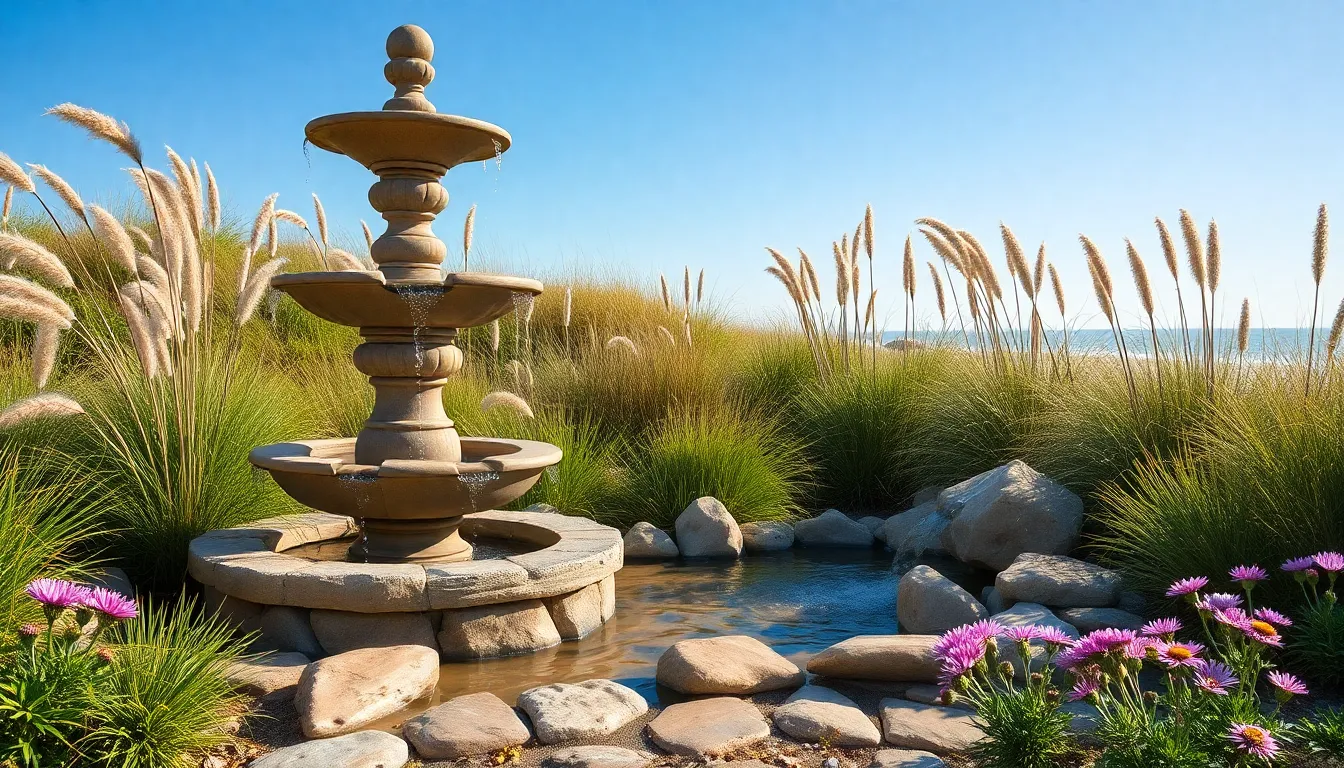
Creating a seaside ambiance in our coastal garden requires thoughtful water feature placement that brings the soothing sounds of the ocean to our outdoor space. We’ll transform our beach garden into a tranquil retreat by selecting water elements that naturally complement our existing pathways and windbreak plantings.
Fountain Designs with Wave-Like Patterns
Tiered stone fountains create cascading water effects that replicate the rhythmic flow of ocean waves against the shore. We recommend positioning these fountains near seating areas where the gentle splashing sounds can be fully appreciated. Metal fountain designs with curved edges produce wave-like water patterns that dance in coastal breezes, adding both visual and auditory appeal to our garden spaces.
Multi-level water displays offer varying sound intensities by allowing water to flow from different heights and surfaces. Stone materials like slate or granite work exceptionally well in coastal environments because they resist salt corrosion while maintaining their natural appearance. Installing fountains with adjustable flow controls lets us customize the water sound intensity based on seasonal wind patterns and personal preferences.
Pond Systems with Coastal Plant Borders
Beach grass borders around pond edges create natural transitions between water features and surrounding garden areas. We’ve found that native species like dune grass and little bluestem thrive in pond proximity while adding texture and movement. Coastal plant selections should include salt-tolerant varieties such as sea lavender and beach asters that flourish in moist sandy soil conditions.
Drought-tolerant succulents provide low-maintenance pond borders that require minimal irrigation beyond natural rainfall. Prickly pear cactus and ice plant varieties create striking contrasts against water surfaces while maintaining their resilience in harsh coastal conditions. Adding small waterfalls or bubbling features enhances the ocean-like sound effects while supporting healthy pond ecosystems.
Integrated stream systems connect multiple pond areas to create continuous water flow throughout our garden space. Native coastal shrubs like shore juniper and wax myrtle positioned along stream banks offer natural windbreaks while maintaining the authentic beach garden aesthetic.
Rain Chains That Echo Gentle Rainfall
Copper rain chains replace traditional downspouts to create melodic water sounds that mimic gentle ocean rainfall. We position these chains where they’ll catch natural rainfall and direct it toward planted areas or collection basins. Different chain link styles produce varying sound qualities, from soft tinkling to deeper resonant tones that complement our fountain and pond features.
Decorative collection basins at rain chain bases can incorporate coastal elements like shells or smooth river rocks to enhance the beach theme. Installing multiple rain chains around our garden perimeter creates a symphony of gentle water sounds during rainfall events. Chains crafted from weather-resistant materials like stainless steel or treated copper maintain their appearance and functionality in salt air environments.
Strategic placement near windows or outdoor gathering spaces maximizes our enjoyment of rain chain sounds while ensuring proper water drainage away from garden pathways and structures.
Install Weather-Resistant Outdoor Furniture and Decor
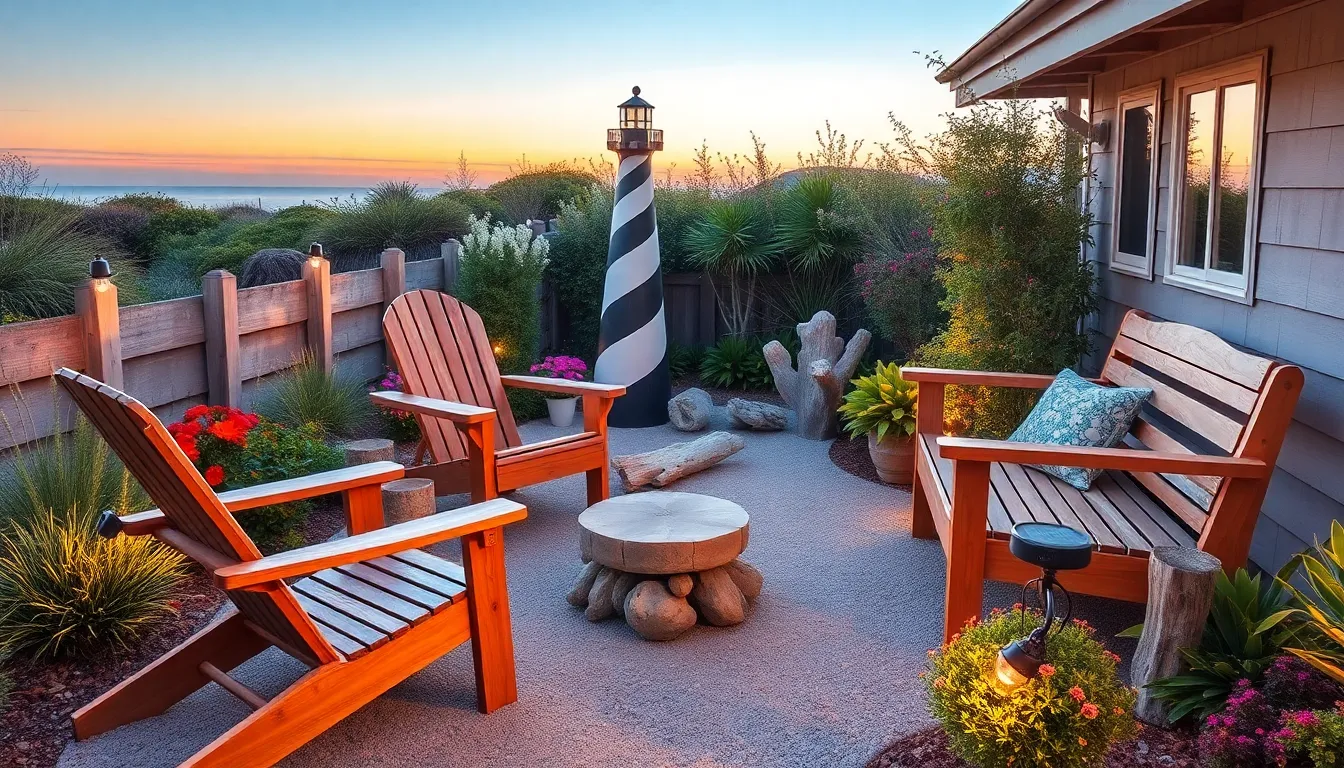
Selecting durable outdoor elements becomes essential when creating your coastal garden paradise. Our focus shifts to choosing materials and decor that withstand moisture, sun exposure, and salt air while maintaining their beauty year after year.
Teak and Cedar Seating Options
Teak furniture offers unmatched durability for beach garden environments, naturally resisting moisture and salt damage without requiring frequent maintenance. Cedar seating provides an equally robust alternative with its inherent weather resistance and attractive grain patterns that complement coastal aesthetics perfectly.
Adirondack chairs crafted from these premium woods deliver both comfort and visual appeal, featuring ergonomic designs that encourage relaxation while blending seamlessly with natural surroundings. Traditional teak benches create gathering spaces for family and friends, developing a beautiful silver patina over time that enhances their seaside character.
Maintenance requirements remain minimal with both wood types, requiring only occasional cleaning and optional oil treatments to preserve their original color. Cedar’s natural oils repel insects and prevent decay, making it particularly suitable for humid coastal climates where other materials might deteriorate quickly.
Nautical-Themed Garden Sculptures
Metal lanterns with weathered finishes serve as focal points throughout your beach garden, creating visual anchors that draw the eye while reinforcing the maritime theme. Lighthouse statues positioned strategically near pathways or seating areas add whimsical coastal charm and can double as subtle directional markers.
Driftwood sculptures bring authentic beach elements directly into your garden design, offering unique textures and organic shapes that no manufactured decor can replicate. Anchor replicas and ship wheel displays provide classic nautical references without overwhelming the natural beauty of your plant selections.
Garden art pieces featuring marine life such as metal seahorses, coral formations, or wave patterns create conversation starters while maintaining the sophisticated coastal atmosphere you’ve carefully cultivated. Rope and net decorative elements can be woven through trellises or used to create borders that tie different garden areas together cohesively.
Solar Lighting for Evening Ambiance
Solar powered lantern style fixtures eliminate the need for complex wiring while providing soft illumination that extends your garden’s usability well into the evening hours. String lights with nautical bulb covers create magical overhead lighting that transforms your outdoor space into an enchanting seaside retreat.
Pathway solar lights with weatherproof housing guide visitors safely through your garden while highlighting key features like sculptures, water elements, or specimen plants after dark. LED solar spotlights can dramatically illuminate larger features such as fountains or focal point trees, creating depth and visual interest in your nighttime industry.
Energy efficiency makes solar lighting an environmentally conscious choice that reduces electricity costs while providing reliable illumination throughout the seasons. Battery backup systems in quality solar fixtures ensure consistent performance even during cloudy periods, maintaining your garden’s evening appeal regardless of weather conditions.
Build Raised Beds to Improve Drainage and Soil Quality
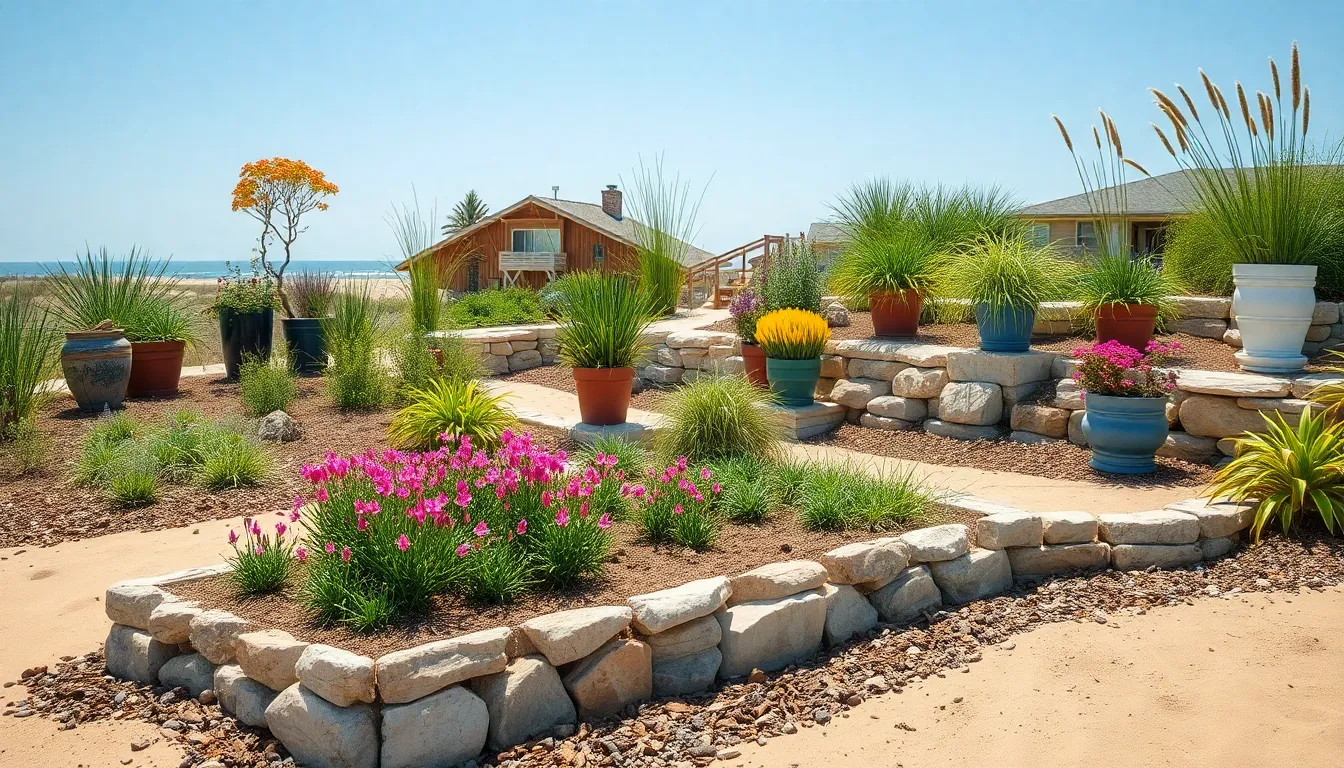
Raised beds transform coastal gardening by elevating your planting areas above problematic sandy soil. These elevated structures provide superior water circulation and aeration that’s essential for healthy plant growth in beach environments.
Container Gardens for Easy Plant Rotation
Container gardening offers unmatched flexibility for coastal gardens where weather patterns can shift unexpectedly. We recommend selecting weather-resistant containers made from materials like fiberglass, concrete, or high-quality resin that withstand salt spray and UV exposure.
Strategic plant rotation becomes effortless with containers, allowing us to move sensitive plants to protected areas during storms or harsh weather conditions. Different container sizes accommodate various plant types, from small succulents in 6-inch pots to larger shrubs in 20-gallon containers.
Drainage holes are crucial for container success in coastal environments where heavy rains can waterlog plants quickly. We suggest adding a layer of gravel or broken pottery shards at the bottom of each container to enhance water flow and prevent root rot.
Terraced Planting Areas for Sloped Terrain
Terracing creates multiple planting levels that prevent soil erosion while maximizing growing space on sloped coastal properties. Stone retaining walls work exceptionally well for beach gardens, using natural materials like fieldstone or concrete blocks that complement the coastal aesthetic.
Each terrace level should be approximately 2-3 feet wide to provide adequate root space for most coastal plants. Proper grading ensures water flows naturally from level to level without creating wash-out areas or standing water problems.
Native beach grasses like dune grass and little bluestem thrive on terraced slopes, helping to stabilize soil between planted areas. These grasses create natural texture while their deep root systems bind sandy soil effectively.
Mulching Techniques to Retain Moisture
Organic mulches like shredded bark, wood chips, or coconut coir help retain precious moisture in sandy coastal soils that drain rapidly. We apply mulch in 2-3 inch layers around plants, keeping it several inches away from plant stems to prevent rot and pest issues.
Gravel mulch offers an excellent alternative for succulent gardens and Mediterranean-style plantings that prefer drier conditions. River rock or crushed shell mulch echoes the beach environment while providing excellent drainage and heat retention for sun-loving plants.
Timing matters when applying mulch in coastal gardens, with early spring and fall being ideal seasons when plants are establishing new growth. Fresh mulch applications before summer help plants survive intense heat and salt-laden winds that characterize peak beach season.
Add Architectural Elements That Complement Coastal Aesthetics
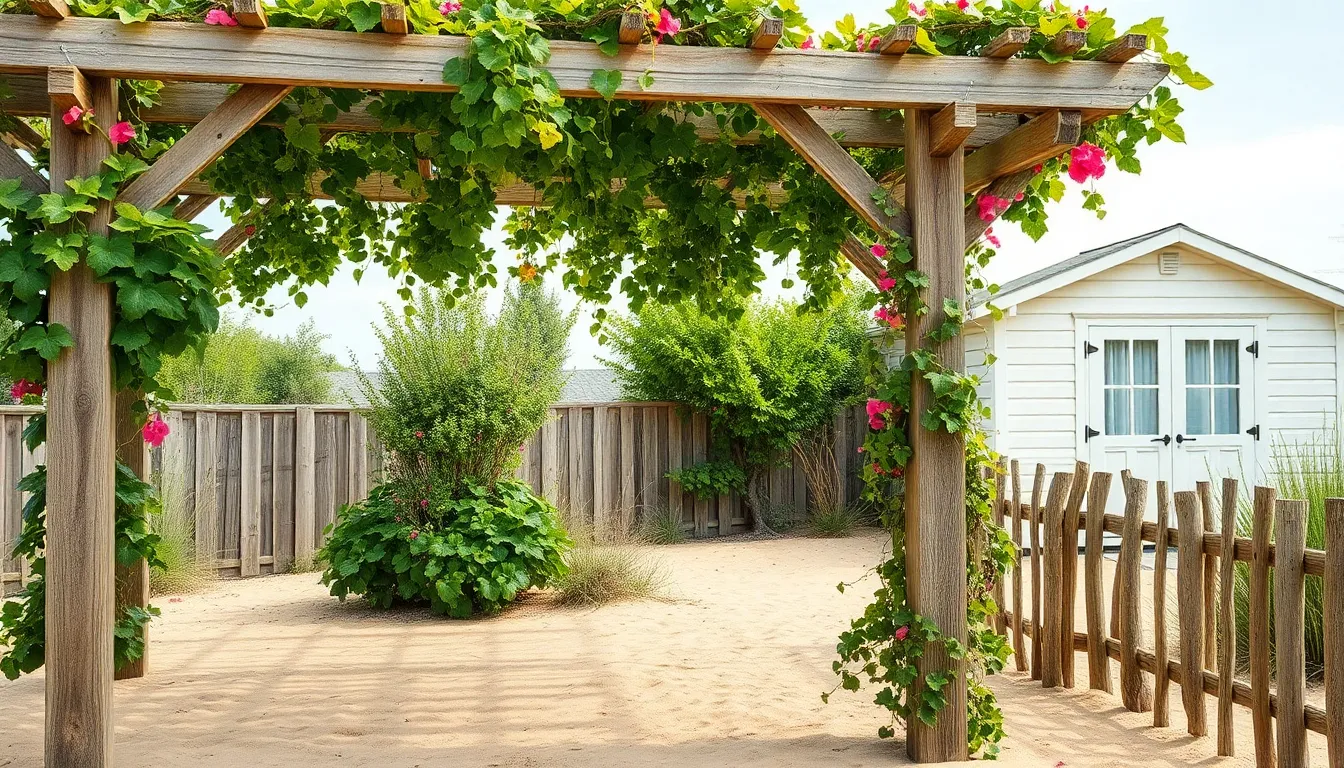
Structural features enhance the natural beauty of coastal gardens while providing practical benefits that withstand harsh seaside conditions. These architectural elements create focal points and functional spaces that harmonize with ocean environments.
Pergolas and Arbors for Climbing Vines
Pergolas crafted from weathered wood create stunning vertical interest while offering essential shade in coastal settings. We recommend positioning these structures to frame ocean views and establish intimate seating areas where families can gather. Natural wood pergolas support climbing vines like bougainvillea, jasmine, and passionflower, which add vibrant colors and attract beneficial pollinators to your garden space.
Arbors serve as dramatic entry points that welcome visitors into different garden zones. These structures work exceptionally well when paired with climbing vines that soften their architectural lines. We’ve found that pergolas and arbors constructed from naturally weathered materials blend seamlessly with coastal aesthetics while requiring minimal maintenance over time.
Beach Hut-Style Garden Sheds
Garden sheds designed with beach hut aesthetics combine practical storage with charming coastal appeal. We suggest choosing light colored finishes that reflect heat and complement the sandy environment around your garden. Shiplap siding adds authentic nautical texture while overhanging roofs provide protection from both sun and salt spray.
These elevated structures protect stored items from sand infiltration and moisture damage common in coastal areas. Windows and louvered doors ensure proper ventilation while maintaining the shed’s decorative function. We recommend positioning these sheds strategically to serve as focal points that enhance your garden’s overall coastal theme.
Rope and Driftwood Fencing Options
Driftwood fencing creates organic boundaries that celebrate the natural materials found along shorelines. We use these rustic barriers to define garden spaces while maintaining the unstructured style typical of beach environments. Rope detailing adds nautical flair and creates visual interest without blocking ocean breezes that plants need for healthy growth.
These eco-friendly fencing options withstand salt air exposure better than traditional materials. Driftwood naturally weathers to beautiful gray tones that complement neutral coastal color palettes. We’ve discovered that combining rope and driftwood elements creates unique boundary answers that require virtually no maintenance while improving your garden’s authentic seaside character.
Establish Outdoor Living Spaces for Entertaining

Creating functional outdoor living areas transforms your coastal garden into the perfect backdrop for memorable gatherings and relaxation.
Fire Pit Areas with Sand Surrounds
Fire pit areas surrounded by sand create an authentic beach atmosphere that guests will love. Natural stone or driftwood structures work beautifully for the fire pit design, blending seamlessly with your coastal theme while providing durability against salt air and moisture.
Sand surrounds offer excellent drainage and safety benefits, containing any sparks while maintaining that quintessential beach feel. We recommend positioning the fire pit at least 10 feet away from any structures or flammable plantings to ensure safety. Consider adding weathered wood benches or stone seating in a circle around the pit to encourage conversation and connection.
Solar powered LED lights embedded in the sand perimeter provide subtle illumination without overwhelming the natural fire glow. Ring the area with native coastal grasses like little bluestem or dune grass to create a natural buffer that helps contain the sand while adding texture and movement.
Outdoor Kitchen Zones with Sea Views
Outdoor kitchen zones positioned to maximize ocean views turn meal preparation into a scenic experience. Stainless steel appliances and marine grade materials withstand coastal conditions while maintaining their appearance season after season.
Layout your cooking area in an L shaped or galley configuration to maximize efficiency and sea facing exposure. Built in grills, weatherproof storage cabinets, and granite or concrete countertops create a fully functional space that rivals indoor kitchens. Consider adding a serving bar with barstool seating where guests can gather while enjoying panoramic water views.
Wind resistant glass panels or bamboo screens provide protection from coastal breezes without blocking the spectacular scenery. Install proper drainage systems beneath the kitchen area to handle occasional storms and salt spray cleanup. Incorporate native shrubs like wax myrtle or shore juniper around the perimeter for natural windbreak protection and visual softening.
Hammock Gardens for Relaxation
Hammock gardens create intimate retreat spaces where you can unwind while listening to ocean sounds. Sturdy palm trees or specially installed posts support hammocks positioned to capture cooling sea breezes and optimal shade throughout the day.
Freestanding hammock structures offer flexibility for placement and can be moved seasonally to follow the best conditions. Surround hammock areas with privacy screens made from bamboo panels or tall ornamental grasses like pampas grass for intimate seclusion. Add weatherproof outdoor pillows and throws in coastal colors like seafoam green, sandy beige, and ocean blue for enhanced comfort.
Ground level plantings of low maintenance succulents such as ice plant or sedum varieties require minimal care while providing year round color and texture. Consider creating multiple hammock zones throughout your garden to accommodate different preferences for sun exposure and privacy levels.
Conclusion
Creating your dream beach garden doesn’t have to be overwhelming when you’ve got the right strategies and plant selections. We’ve covered everything from salt-tolerant perennials to natural windbreaks that’ll protect your coastal paradise from harsh elements.
Remember that successful beach gardening comes down to working with nature rather than against it. Choose native plants that thrive in sandy soil embrace the unique challenges of coastal living and incorporate materials that complement your seaside environment.
Your beach garden can become a stunning retreat that requires minimal maintenance while providing maximum enjoyment. Start with one or two elements we’ve discussed and gradually build your coastal oasis into the envy of your neighborhood.
Frequently Asked Questions
What are the best plants for coastal gardens with sandy soil?
Salt-tolerant perennials like blanket flowers, sea lavender, beach asters, and seaside goldenrod are excellent choices for coastal gardens. Native beach grasses such as dune grass, little bluestem, and switch grass also thrive in sandy conditions while preventing erosion. Drought-resistant succulents including prickly pear cactus, ice plant, sedum varieties, and aloe species require minimal maintenance and handle harsh coastal conditions well.
How can I protect my coastal garden from strong winds?
Create natural windbreaks by planting wind-tolerant species in dense rows. Tall ornamental grasses like pampas grass and sea oats serve as effective living screens. Evergreen shrubs such as shore juniper and wax myrtle provide permanent protection against salt spray. Bamboo clusters offer rapid growth and create excellent privacy barriers while requiring minimal maintenance once established.
What materials work best for coastal garden pathways?
Shell and pebble walking trails provide excellent drainage and visual interest while withstanding harsh coastal conditions. Driftwood borders offer rustic appeal and natural edging that complements the coastal theme. Sand-stabilized stone pavers create stable walking surfaces that maintain the sandy aesthetic while preventing erosion and requiring minimal maintenance.
How can I incorporate water features in my coastal garden?
Tiered stone fountains and metal designs with wave-like patterns positioned near seating areas create soothing ocean-like sounds. Multi-level water displays using durable stone materials offer both aesthetic and functional benefits. Pond systems bordered by coastal plants like dune grass thrive in moist sandy soil, while integrated stream systems can connect multiple water areas throughout the garden.
What furniture materials withstand coastal weather conditions?
Teak and cedar are excellent choices for outdoor furniture as they naturally resist moisture and salt damage while requiring minimal maintenance. These durable hardwoods can withstand harsh coastal conditions better than other materials. Nautical-themed garden sculptures made from weather-resistant metals and treated driftwood also complement the maritime theme while standing up to salt air and wind.
How do I improve soil drainage in my coastal garden?
Building raised beds elevates planting areas above sandy soil for better water circulation and improved soil quality. Container gardening offers flexibility for plant rotation during adverse weather while ensuring proper drainage. For sloped areas, create terraced planting zones using stone retaining walls and native grasses for stabilization and erosion prevention.
What mulching techniques work best for sandy coastal soil?
Organic mulches help retain moisture in sandy soils and should be applied during optimal seasons for maximum effectiveness. Gravel mulches work well for different plant types, particularly around succulents and drought-tolerant species. The key is selecting the right mulch type for your specific plants and applying it at the correct depth to prevent moisture loss.
How can I create outdoor entertaining spaces in my coastal garden?
Fire pit areas with sand surrounds create an authentic beach atmosphere using natural stone or driftwood structures. Outdoor kitchen zones should maximize ocean views while featuring durable, weather-resistant materials and efficient layouts. Hammock gardens surrounded by privacy screens and low-maintenance plantings offer intimate retreat spaces perfect for relaxation and small gatherings.

